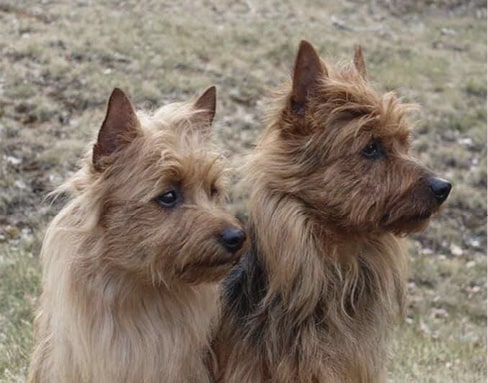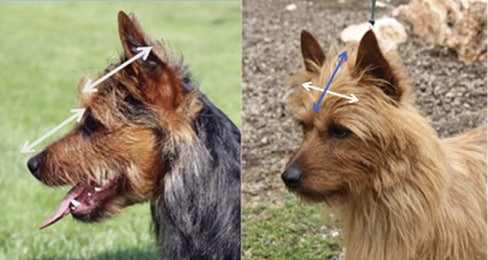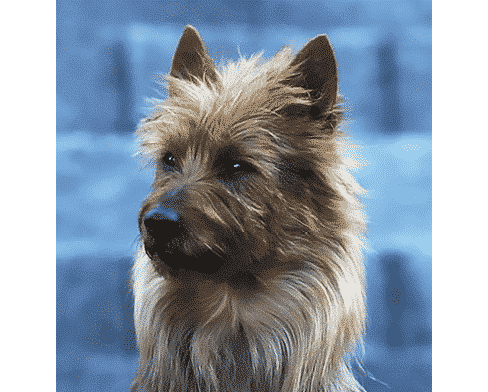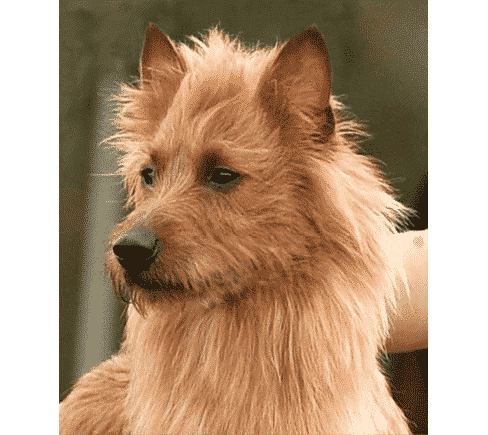Bred in Australia to be both a companion and a working Terrier, “Aussies” were first shown as rough-coated Terriers in 1868 in Melbourne. In 1909, the breed was officially recognized as the Australian Terrier in all states of Australia. They were accepted into the American Kennel Club registry in 1960.
History suggests that they developed from the Terriers of the British Isles that were available in Australia at the time. These include: the old Scotch Terrier (not to be confused with the modern Scottish Terrier), the Skye Terrier, the Dandie Dinmont Terrier, the old Black & Tan Terrier, and the Irish Terrier. It is thought that the colors are derived from the Skye, Dandie, and Irish, with the Dandie Dinmont contributing the topknot.

Early breeders developed dogs that hunted vermin (including snakes), guarded gold mines, herded sheep and cattle, and were fiercely loyal and protective companions capable of withstanding the harsh life in the Australian bush. Breeders kept no pedigrees during this time.
As settlers created a small, sturdy Terrier that suited their needs, and as breed type developed, so did a standard for the breed. A breed standard is the descriptive words used to guide breeders in maintaining type, temperament, and function.
They wanted:
- A spirited, courageous worker, but also a good companion;
- Rough-coated dogs with a harsh, outer body coat and an undercoat to withstand all weather;
- Blue and tan, sandy or red in color;
- A head that was long and strong, with jaws that were punishing and powerful;
- A head that was furnished with a soft, silky topknot lighter in color than the head, and a ruff that would protect the head and neck.
The Australian Terrier head is distinctive, setting it apart from other small Terrier breeds.

Viewing the Australian Terrier Head from the Side
Judging and viewing the Australian Terrier head from the side, it is long and strong, and the muzzle is equal in length to the skull, with jaws that are strong and powerful. The punishing jaws are important to a working Terrier as they enable a dog to dispatch prey in a quick and efficient manner, lessening the chance of injury while getting the job done. The muzzle appears squared at the front, coming down from the nose, passing the lips to the chin. An underjaw that recedes creates a weak chin, lessening the strength of the muzzle.

Moving on to the skull from the muzzle, perceive the slight but definite stop. The top of the skull is flat and covered with a soft, silky topknot. The planes of the skull and muzzle are parallel. The pointed tips of the ears will be visible above the topknot. A ruff frames the head, blending down to the apron. The topknot and the ruff are hallmarks of the Australian Terrier.
Viewing the Australian Terrier Head from the Front
The expression is keen. There is intensity and intelligence in the gaze, an alertness to the activities going on in its surroundings as befits a working Terrier.
The top skull is slightly longer than it is wide, and this is an important proportion for correct head shape. This proportion is determined by measuring the length of the skull from the occiput to the stop, and the width is measured side-to-side across the top of the skull. The sides of the skull should be clean, not cheeky or heavy, and the hair on the cheeks is kept shorter. Below and on the muzzle there will be slightly more hair.

Judges should check for the flatness of skull and the slight but definite stop. One should see a muzzle that is strong and powerful, with a slight fill below the eyes. The strong jaws with large teeth meet in a scissors bite. Judges have been surprised by the size of the teeth, as Aussies are one of the smaller breeds in the Terrier Group. The large teeth and strong punishing jaws are important for catching and dispensing prey efficiently and safely. The lips are framed by dark brown to black rims and are tight.
The eyes are set well apart and at a slightly oblique angle. The oval shape of the small, dark brown to black eyes (the darker the better) contributes to the correct expression. The rims are black. Faults: Light–colored or protruding eyes.** Large, round, light-colored or prominent (slightly bulging) eyes are incorrect. Lack of pigmentation, liver pigmentation or an excessive amount of black pigmentation give a foreign expression.*

The small, erect ears are set-on high and well apart. They are free of long hair inside and out. The tips are pointed, not rounded, and the ears are not coarse or thick. There should be no tendency to flare at an oblique angle off the skull. There should be no leaning of the ears at the base inward toward each other.* If the ear has a vertical edge it must be the outer edge of the ear.
Aussies are sensitive in the use of their ears. When you approach a dog on the table it may sometimes turn its ears to the side or back, which is a friendly gesture. Because they are sensitive in the way they use their ears, often dogs not willing to use them on the table will do so willingly when placed back on the ground. Sometimes they will move their ears to the side or back when gaiting. Their keen sense of hearing is one of the traits that made them a prized companion animal and guard dog.

The nose color is black. Aussies may have an inverted V-shaped area free of hair (leather) that runs up from the nose in the direction of the stop. The color of the leather is black. This desirable trait is found in varying lengths in a mature dog, but not all dogs will have it.
A ruff and topknot are hallmarks of the breed. In all colors, the topknot is lighter than the head color. It is furthered described in the standard: Topknot – Covering only the top of the skull; of finer and softer texture than the rest of the coat.**
The ruff frames the head, covers the neck, and blends into the apron. This protective ruff under the throat should not be clipped or completely stripped. The ruff protects the throat from injury and is an important feature, developed to protect the dogs as they worked. A bare throat would leave it vulnerable to bites from the prey it hunts.
The form of the head is important to the functions for which it was bred.
The Australian Terrier is spirited, alert, courageous, and self-confidant, with the natural aggressiveness of a ratter and hedge hunter; as a companion, friendly and affectionate.
Faults; Shyness or aggressiveness toward people.**
** The Standard for The Australian Terrier approved by the Board of Directors of the American Kennel Club.
* THE ILLUSTRATED CLARIFICATION OF THE STANDARD
Copyright 1994 by The Australian Terrier Club of America, Inc.
Compiled, written, and edited by I. E. Weinstock and K. Barnes.
From the November 2021 issue of Showsight Magazine.














